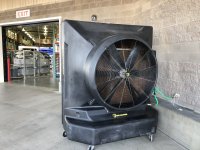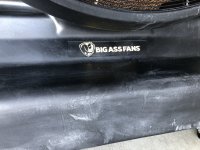Air dryer design error fixed and mounted to the wall in the tank room. Also got the rest of the LED shop lights put up. STILL waiting for the $(*$%ing power company...
-
Enjoy XS650.com? Consider making a donation to help support the site.
XS650.com receives a small share of sales from some links on this page, but direct donations have a much greater impact on keeping this site going.
You are using an out of date browser. It may not display this or other websites correctly.
You should upgrade or use an alternative browser.
You should upgrade or use an alternative browser.
Real Estate Update
- Thread starter Downeaster
- Start date
Air dryer design error fixed and mounted to the wall in the tank room. Also got the rest of the LED shop lights put up. STILL waiting for the $(*$%ing power company...
Dang! for a second I thought you were going to use that as your air tankto make sure you had enough supply to run the blast cabinet!
Hey DE, I was at Costco today and I saw something you need for your shop, to keep cool in the summer. This ginormous swamp cooler stood over 6’ tall!And believe me, it moved some air!
Not sure one of those would work too good up in Maine, Did not check weather for today but would not be surprised if the humidity there was in the mid to upper 70% range or higher, where I think in your area it would be below 50%.
Yeah some days I open the basement garage/shop door and EVERYTHING is bathed in "sweat", water literally puddling on the floor.As much rain as we've had this Summer, I've already GOT the swamp, what I need is the cooler!
And @kshansen is right. FAR too humid up here for a swamp cooler to work. Already looked into that.
Yeah some days I open the basement garage/shop door and EVERYTHING is bathed in "sweat", water literally puddling on the floor.Hard on the tools and equipment.
Little tip in that regard:
I have the same problem seasonally in my garage. I put a little lump (thumbnail sized) of raw camphor in a plastic film can with a couple of holes punched in it in every drawer of my tool box. Doesn't stop the condensation, but it keeps rust from forming on the tools. Can't recall where I found that info, but it works.
Last edited:
Also, I cover all my equipment - table saw, drill press, lathe, welder, plasma cutter - with terrycloth towels when not in use. Keeps the condensation off tables and ways and such.
One side benefit: Happy wife. I spring for a complete new set of towels and washcloths every couple of years. New ones in the main bathroom, ones from the main to the upstairs half-bath, ones from upstairs to the garage.
One side benefit: Happy wife. I spring for a complete new set of towels and washcloths every couple of years. New ones in the main bathroom, ones from the main to the upstairs half-bath, ones from upstairs to the garage.
I have to do the same here, It's pretty humid in the MoKan/Mo River valley area. I always keep a towel on my little lathe.Also, I cover all my equipment - table saw, drill press, lathe, welder, plasma cutter - with terrycloth towels when not in use. Keeps the condensation off tables and ways and such.
One side benefit: Happy wife. I spring for a complete new set of towels and washcloths every couple of years. New ones in the main bathroom, ones from the main to the upstairs half-bath, ones from upstairs to the garage.
Couple things I regret are: When I built the garage I didn't do two things. Both related to the floor slab. Frist wish I had put down a heavy layer of plastic under the slab and a layer of foam insulation. Second would be to have thought ahead to possibility of heating and included tubing in the slab for hot water heat.
Bet between the two I could save money on heating in the winter and also not have the problem of the sweating floor mostly in the spring.
Bet between the two I could save money on heating in the winter and also not have the problem of the sweating floor mostly in the spring.
It's amazing how much moisture will migrate through concrete floors and walls. House I'm in now was unfinished "daylight" basement, poured concrete walls 3 sides and concrete floor.
I had a dehumidifier I used at my last rental prior to the purchase of this home and I put it down stairs, it holds about 2 gallons. Midsummer I could empty it twice a day.
I bought Stay-Dry masonry paint, applied two coats to the walls and sealed the floor prior to finishing it out so my wife could work there. Once that was done I still use the dehumidifier back in the downstairs single "boat garage" which is as yet not totally finished and only have to empty it maybe once a week.
I had a dehumidifier I used at my last rental prior to the purchase of this home and I put it down stairs, it holds about 2 gallons. Midsummer I could empty it twice a day.
I bought Stay-Dry masonry paint, applied two coats to the walls and sealed the floor prior to finishing it out so my wife could work there. Once that was done I still use the dehumidifier back in the downstairs single "boat garage" which is as yet not totally finished and only have to empty it maybe once a week.
Cobbled up enough plumbing bits to pressure test the air dryer this morning. Only had to reflow one joint.
I was pleased...and a little surprised considering it was mostly used fittings and pipe. And how long it's been since I did any sweat soldering...
I was pleased...and a little surprised considering it was mostly used fittings and pipe. And how long it's been since I did any sweat soldering...
Little tip in that regard:
I have the same problem seasonally in my garage. I put a little lump (thumbnail sized) of raw camphor in a plastic film can with a couple of holes punched in it in every drawer of my tool box. Doesn't stop the condensation, but it keeps rust from forming on the tools. Can't recall where I found that info, but it works.
Now THAT is a cool idea - which I am gonna swipe!
Thanks DE!
Couple things I regret are: When I built the garage I didn't do two things. Both related to the floor slab. Frist wish I had put down a heavy layer of plastic under the slab and a layer of foam insulation. Second would be to have thought ahead to possibility of heating and included tubing in the slab for hot water heat.
Bet between the two I could save money on heating in the winter and also not have the problem of the sweating floor mostly in the spring.
I have already planned for in-floor heating operated by a small NG boiler plus a good sized mini-split for AC.
Keep those ideas comin' guys - I am in the planning stage and I'll only get one chance for Senior Management approval, so it has to be right.
P
I guess it goes without saying that if you think 10 electrical outlets are enough double that number! Also include a 220 volt outlet or two. I put one in thinking I was going to get a small welder but instead I use it to run the old kitchen electric stove. Comes in handy for baking on paint or heating bearings.
Plus I have used it a couple times, once just this weekend, when power goes out. Just throw the main breaker in the house and plug in portable gen set. Best thing might be to wire in a master switch to go between the two power sources but power ony goes out at the most once a year here so I can remember to do the switching manually.
Plus I have used it a couple times, once just this weekend, when power goes out. Just throw the main breaker in the house and plug in portable gen set. Best thing might be to wire in a master switch to go between the two power sources but power ony goes out at the most once a year here so I can remember to do the switching manually.
Actually; that's a code requirement. A very important one. Things often get confused during emergencies.wire in a master switch to go between the two power sources
LInemen get really testy when they get juice coming out of "dead" lines..............
Transformers work both ways.
That 220 outlet will be for your charging station in the near future...I guess it goes without saying that if you think 10 electrical outlets are enough double that number! Also include a 220 volt outlet or two. I put one in thinking I was going to get a small welder but instead I use it to run the old kitchen electric stove. Comes in handy for baking on paint or heating bearings.
Plus I have used it a couple times, once just this weekend, when power goes out. Just throw the main breaker in the house and plug in portable gen set. Best thing might be to wire in a master switch to go between the two power sources but power ony goes out at the most once a year here so I can remember to do the switching manually.
I have an attached garage, I made sure to have the builder stub in plumbing for a slop sink. Best thing I did. My outlet placement wasn't the best however.
Last edited:
Can you turn the counter top around?View attachment 197110
I have an attached garage, I made sure to have the builder stub in plumbing for a slop sink. Best thing I did. My outlet placement wasn't the best however.
Similar threads
- Replies
- 31
- Views
- 3K



